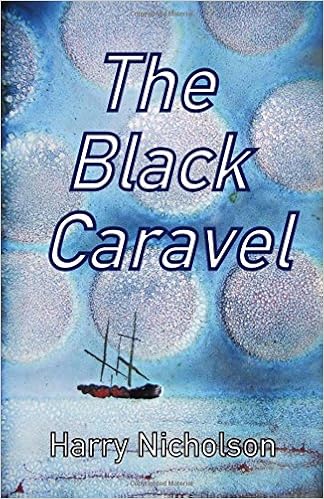The Black Caravel by Harry Nicholson is his second novel about Tom Fleck: a Novel of Cleveland and Flodden, which I reviewed in 2011.
Blurb:
This story follows the struggles of a farm labourer in North-East England. The series began with the novel, ‘˜Tom Fleck’, in which we followed Tom’s adventures, loves, and troubles in the year 1513, the year of the Battle of Flodden. The present book re-enters his life twenty-three years later in 1536, in the dark year of the dissolution of the monasteries and the subsequent rebellion known as ‘˜The Pilgrimage of Grace’. Tom is on a journey with his wife and blind daughter and must travel through the chaos.
My view:
Once again I was transported back to the 16th century with Tom Fleck and his family, this time it is 1536. He now has grown-up sons, Francis and Isaac, both at sea, part of the crew of the Plenty under Captain Ben Hood, a daughter of seventeen, Kate, who is blind and twins aged 15. Tom is now a farmer, living for the past twenty years at Crimond Hall on the Durham coast. As Henry VIII’s dissolution of the monasteries begins Tom and Rachel, his wife, together with their daughter Kate set out for London to visit a lawyer as Rachel has been bequeathed five hundred gold sovereigns in her father’s friend’s will.
As the blurb indicates their journey is not without danger, bringing them into contact with the rebels led by Robert Aske (a real historical character who led the Pilgrimage of Grace protest). Tom’s sons, Francis and Isaac are also in trouble as the Plenty runs aground on the Goodwin Sands in the Dover Straits, encounters a ‘plague ship’, a grounded Portuguese caravel with just one man and a dog left on on board, and engages battle with Barbary pirates from North Africa.
The Black Caravel is a fascinating story about ordinary people set against the background of national affairs and how it affects their lives, for example one character refers to ‘poor Anne Boleyn what’s got no head‘ and he thinks that Richard of York was the true King, not Henry VIII. I was immersed in the time and place – the landscape, the bird sounds, the plants and animals, the towns and the seascape are all beautifully described; for example this passage describing the scene as the fog over the Goodwins lifted:
The fog shifted. Then swirled. Driven before a freshening breeze the murk swept away to the northeast. The shore boat approached the grounded Plenty in bright noon sun. In the shallows around her, the sea was a burnished duck-egg green. Farther out, the surface glowed steel-bright and sparkled with a million ripples. The drying sandbanks threw back white light, fierce to the eyes.
An urgent shout came from the Plenty. The rowers bent harder. A hoard of dark shapes undulated across the sandbank. The seals bugled in alarm while they jostled to plunge into the sea. A flock of pied birds lifted in panic before the approach of men who ran full tilt armed with crossbows and spears. The oystercatchers flew overhead, bleating. Urgent hands reached over the side to heave the heavy captain onto the deck of the cog.(page 59)
There is so much packed in this short novel, reflecting the way of life and the attitudes of the times such as the religious fervour as England broke away from Rome, the ways of treating illness (Kate is blind as a result of a blow to her head) and the anti-semitism that prevailed. I thoroughly enjoyed reading it.
My thanks to Harry Nicholson for sending me a copy to read and review.
- Paperback: 188 pages
- Publisher: CreateSpace Independent Publishing Platform (30 Aug. 2016)
- Language: English
- ISBN-10: 1535378085
- ISBN-13: 978-1535378086
- Source: Review copy from the author

>There is so much packed in this short novel, reflecting the way of life and the attitudes of the times
Sounds absolutely perfect!
>the landscape, the bird sounds, the plants and animals, the towns and the seascape are all beautifully described
I love novels that really create a world I can inhabit while I read–these are the details that constitute that world.
LikeLike
Oh, I do like an engaging, absorbing historical novel, Margaret. And it sounds as though this one really shows the times through the lives of real, human people, which I particularly like. Thanks for sharing.
LikeLike
Sounds like a good series. Thanks for an interesting review 🙂
LikeLike